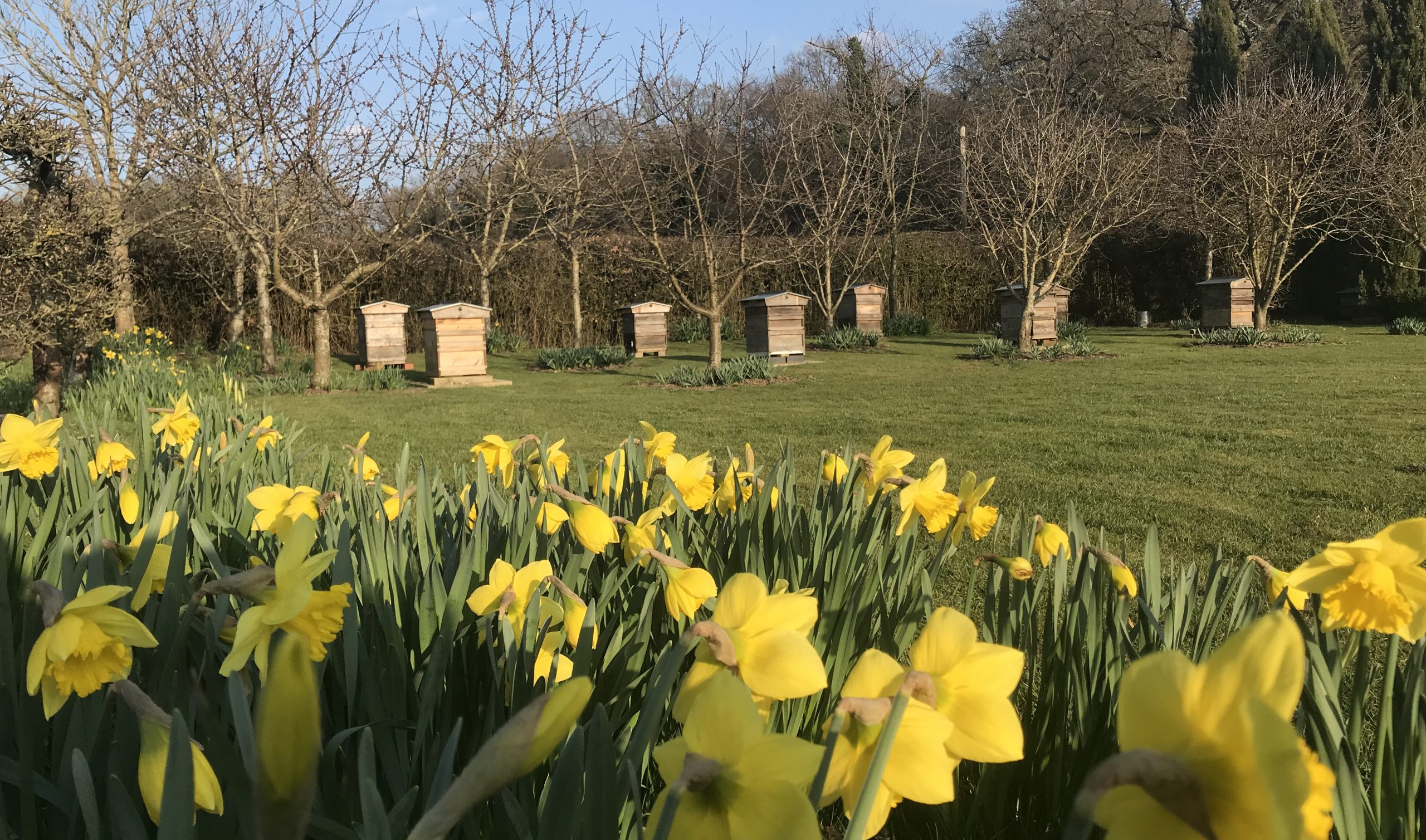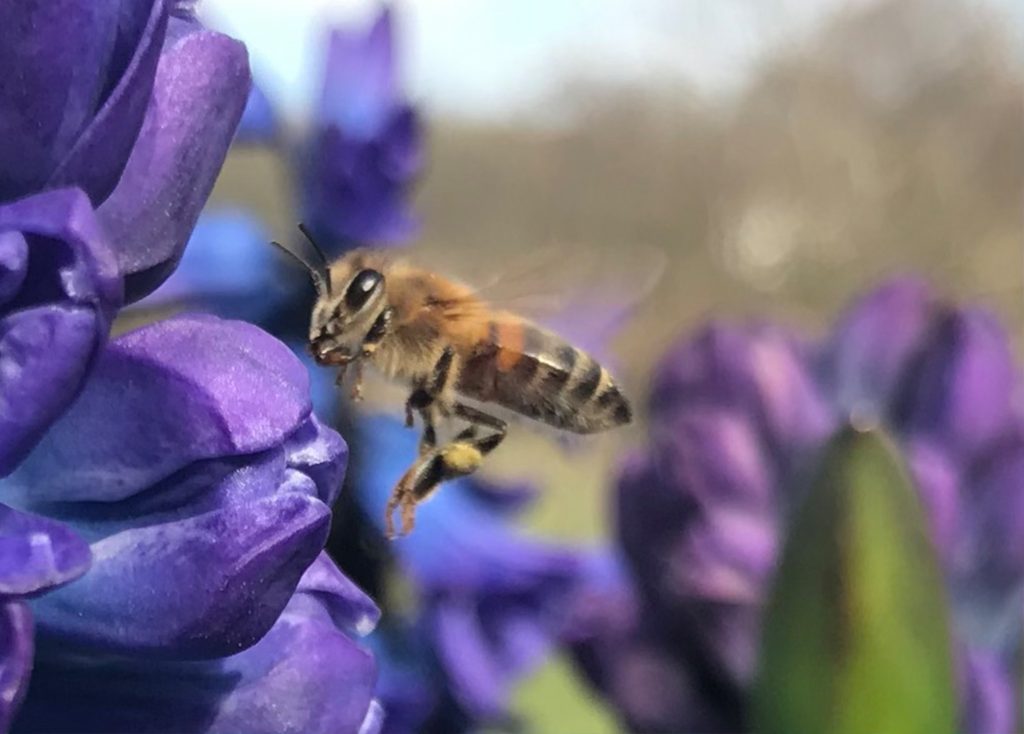Bee blog for March: gardens and bees go together like ham and cheese

A big thank you to the National Garden Scheme for asking me to write a monthly blog. Here we are at the end of March and my role as beekeeper is just starting. I did not want to miss out on this, the first month of spring, so the blog will be about what happened in March rather than what we can look forward to in the month. April will be upon us in no time and I will be writing again soon about what is coming up for the bees (and the garden). A blog posted early in the month is the agreed format going forward.
Southlands Lodge is in rural East Surrey, we are at the foot of the North Downs overlooking the Weald Basin, surrounded by farmland and woods. The house is in a frost hollow so mornings are cold early in the year and remain so until well into the day as the woodland on our southern boundary casts a long shadow. The soil is an alkaline, heavy clay. So there are challenges; both as a beekeeper and a gardener.
It is too cold to open the hives in March. However, you can infer a great deal about what is going on inside by observing the front of the hive and watching out for the comings and goings at the entrance on a warmish spring day.
10 March observations for the beekeeper:
- Dead bees at the hive entrance; not necessarily a bad sign. Winter casualties are being removed from the hive. There is life!
- Brown faeces on the front of the hive: a sign of dysentery
- Scraps of comb on the entrance porch: an indication that a rodent has overwintered in the hive
- Activity at the hive entrance: at least some bees have got through the winter!
- Bees flying with purpose: a good sign that all is well
- Do the bees look healthy? a gauge of the varroa mite level
- Pollen being brought home. Yellow ‘saddlebags’ of protein on the workers legs is the sign that the queen is alive and in lay. A red letter day for beekeepers
- Hovering bees at the hive entrance. These are young bees orienting themselves to their home. Eggs were laid at least 21 days ago.
- Bees flying at the hive entrance with their heads up and legs down are robbers: a sign that the hive is weak or queen-less and is being raided
- Larvae eggs at the entrance – a sign of starvation, there are not enough stores to support the expanding nest and drastic measures have been taken by the bees to keep the colony alive. Emergency feeding is needed.
Happily all the colonies here at Southlands have survived the winter. But, I am hearing that there seems to have been a lot more winter colony losses that usual in the area. The risk of losses is still high. Many hives are lost in spring through starvation as the colony requires a great deal of feed to support the expanding brood nest. Young bees are always hungry. A close eye on the hives is critical at this time of year.
In the days ahead I will also be keeping an eye out for the first dandelions to appear. They are the ‘green light’ for the first spring inspection. Something to look forward to on a warm day next month.
Another beekeeping indicator is the first flower in the Oilseed Rape (OSR) field: a sign that it is time to set up a bait hive to catch an early swarm.
I have recently bought a Long Hive (more about this new piece of kit in future blogs), as there is now some yellow in the OSR crop across the road the Long Hive has been filled with old brood frames in the hope of enticing a passing swarm to choose it as a home. Fingers crossed. It is very early in the year for swarms but scouting bees have been sniffing around, so you never know…
Gardens and bees go together like ham and cheese and the following flowers have sustained my colonies in March. The first on the list is the snowdrop, such a pretty and important plant for the Southlands garden. It is heart lifting to hear bees busily foraging in this early flowering bulb on a warm and sunny Spring afternoon. A clear sign that winter is over and the promise of a new year is ahead is indicated:
Good foraging opportunities for bees in March:
Snowdrops
Crocus
Helebores
Daffodils
Lungwort (Pulmonaria)
Willow and hazel catkins
Comfrey (Symphytum Grandiflorum)
Pilewort (Lesser Celandine) weed!
Yew
Laurel (just coming out)
Hyacinths
- Bee on a hyacinth
- Hellebores provide early pollen
- Hyacinths and the apiary
- Oilseed rape is an important food
- Laurel provides early pollen
- Comfrey is great for bees
Next month I will introduce the Long Hive and anticipate the first hive opening and inspection of the the bees. The colonies will be expanding exponentially in the coming weeks and the work of the beekeeper takes off in a big way. The garden needs some attention too. It will be on display to visitors in the summer and the work done at this time of year pays dividends by way of a good show when visitors arrive. Maybe we will meet later in the year and have chat about bees and gardens over a cup of tea and a gluten free slice of cake.
Find out more about our bee-blogger Colin David here
Explore our bee-friendly gardens
























